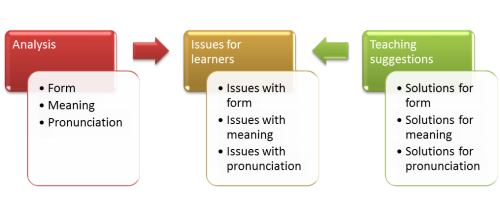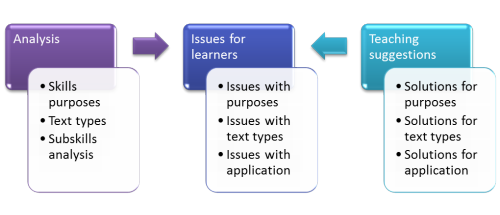How to get a distinction grade – meeting all Delta Module Two essay criteria above pass standard

This is how to get a Distinction for a Background Essay on a
Delta course. There's no warranty about this, of course,
implied or otherwise.
This guide is written by someone with many years of experience as an
assessor and tutor who has read and assessed hundreds of Delta
essays. It is not written by someone who has just finished a
Delta course and claims to know it all.
Before following this guide, make sure you have done
the one to writing a Delta essay.
It may also be helpful, if you have not already done so, to read
through the guide to
choosing an
appropriate topic for a Delta assignment.
Both those guides will open in new tabs.
The first thing to do is to download the PDF document which explains each of the 15 criteria for the Background Essay.
 |
Subject knowledge |
Not even your tutors on a Delta course can magically transfer
their knowledge of this subject into your head.
The purpose of the Background Essay is for you to acquire and then
demonstrate your knowledge of language systems and skills and your
understanding of appropriate methodological approaches to teaching
your selected area.
Only you can acquire the knowledge you need although your tutors and
this website can help you map out what you need to know.
All the following is premised on your willingness to do the thorough
research and reading which is required at this level.
There are related links at the end of this guide to help you do that.
 |
Section 1 – quality of writing |
The criteria for this section are:
Successful
candidates demonstrate that they can effectively present an essay
which:
a) is written in language which is clear,
accurate, easy to follow and is cohesive and clearly ordered
b) uses appropriate terminology accurately
c) refers to and references key sources
d) follows the conventions of a standard referencing system for
in-text referencing and the bibliography
e) respects the word limit (2,000-2,500 words) and states the number
of words used.
The aim here is to make sure that your essay is:
- in accurate English
- in the right style
- clear
- referenced
- knowledgeable
Accuracy, style and clarity in English
Essays which do not fulfil this criterion generally fail
overall.
Of course you can write accurate English or you wouldn't be an
English language teacher, would you? OK, why shouldn't you
write any of these? Decide what's wrong and then click on
the
![]() to reveal some comments.
to reveal some comments.
For more in this area, see the guide to
10 things not to
write in Delta essays and
the guide to writing style for
Delta.
| There's a
plethora of exercises in coursebooks aimed at teaching the
present perfect |
Two problems:
|
| When a teacher
gives their students plenty of practice in this area ... |
In informal language, using their to avoid the
clumsy he/she, his/her formulations is
acceptable. It is not in academic essays so
rephrase in the plural: When
teachers give their students ...
|
| Learners do
not always understand the concept of the perfect aspect in
English, their languages are often very different in this
respect. |
Yuck. This is called a comma splice and should be
two separate sentences or one joined with a semi-colon
at least. If you are prone to this kind of writing
see
the answer on this site about comma splices and
run-on sentences. Avoid them.
|
| A complex
tense form is hard to unpack because learners cannot always
identify it's various parts. |
Yuck again. That should be its. Do
not do this. Other favourite homophones to avoid
are faze/phase, practice/practise and
one's/ones.
|
| Vocab teaching
is an area where authorities differ. |
Do not use abbreviations. That should be
vocabulary (or, better still, focus on lexis).
It should also, incidentally, be in which authorities differ. |
|
Grammatical form: Apart from lexical issues such as encountering unknown words in a text and being unable to use intelligent inferencing strategies to extract at least the gist of the paragraph, for example, ... |
Here you have a subheading which does not match the
paragraph which follows. Cohesion is lost.
This leads the reader astray and duplicates work because the reader has to go back and figure out what the paragraph should be about or, alternatively, what the subheading should have been. |
| Talking to my
students, they tell me they have trouble with listening to
native speakers. |
Beware the dangling participle. The reader needs
to rearrange this sentence to mean something like
When I have asked my students specifically about this
area, they tell me that ...
For more on dangling participles, see the answer and how to avoid them. |
| Correct
intonation can be incredibly important in some situations. |
The word incredibly should never be used in
formal writing to mean extremely or very.
|
| A nice
activity to use in this area is one in which the students
read and notice which sentence messes up the flow of the
text. |
Two problems:
|
Use terminology
- Do not be satisfied with saying,
e.g.,
We use more and most with longer adjectives when comparing or stating a superlative.
The correct term for this is the periphrastic construction so use it and then exemplify so that it is clear that you understand it. - Use terminology accurately. Readers will be deeply
unimpressed if it is clear that you don't understand a term
you are using. For example, if you use a term which is
used more technically in ELT than it is in ordinary life
(such as genre), make it clear that you understand what it
means.
There is a 100-item test on terminology in this section which you may like to do when you have finished this. There's a link at the end.
Referenced and knowledgeable
There is a guide to how to reference conventionally in the general section on essay writing for Delta and none of that will be repeated here. This part is devoted to what you should do with the references you make.
- Don't cite people for the sake of it. If you include a quotation, properly referenced, from an authority, comment on it so that the reader can see that you have understood the point.
- Reference what you assert. If, for example, you want to state that other languages do not have a perfect aspect form (or, if they have, that it is differently used), then say where you got that information.
- Look for opposing views. Readers will be more impressed if you can cite two views which differ on the topic you are discussing. You can then draw on experience to decide which one you feel is the most helpful.
Do not leave yourself open to accusations of plagiarism. A plagiarised essay will automatically fail. Follow a conventional referencing system and never assume that because you have rephrased a thought or idea that you do not need to reference it. You do.
Word limits are not flexible.
Your essay must be between 2000 and 2500 words. If it is near the lower end of that, you haven't covered things in adequate depth. Do not be tempted to cheat on word limits by inserting tables as images or by putting analysis and discussion in appendices which belong in the main text.
 |
Section 2 – clarity and coherence |
The criteria for this section are:
Successful candidates demonstrate that
they can effectively make clear the topic of the essay by:
a) identifying for analysis a specific area of the grammar, lexis,
phonology or discourse system of English, or a skills area
(listening, speaking, reading or writing)
b) defining the scope of the area they will analyse with reference
to e.g. learners, teaching approach, method, learning context,
learner needs or text type
c) explaining with reference to classroom experience, reading and
research why they have chosen this area
d) making all parts of the essay relevant to the topic and coherent
e) following through in later parts of the essay on key issues
identified in earlier parts.
- The title
Choose a title when you start writing and put it in the header or footer of every page. Frequent reference to it will help you stay focused and relevant. However, do not be afraid to go back and re-visit the title when you are writing or think you have finished. Content develops as you write and the title may need to change more than once to reflect that.
The title must make it instantly clear to the reader what your overall topic is (the system or skill) and what aspects of it you are going to consider.
Here are some (real) titles for assignments. Consider their merits and then click on the to reveal some comments.
to reveal some comments.Reading for low-level learners
 This shows the overall topic and limits it to lower-level learners but doesn't go far enough. The title needs to say what sort of reading and what sort of texts. It would be better as, e.g.,
This shows the overall topic and limits it to lower-level learners but doesn't go far enough. The title needs to say what sort of reading and what sort of texts. It would be better as, e.g.,
Helping lower-level learners read authentic news stories to extract essential meaning.Modals of deduction for higher-level learners
 Are you talking about modality or modal auxiliary verbs? There's a difference and it should be made clear in the title which is meant. Otherwise, this is OK but the introduction is going to have to make it very clear what is included and what is excluded and why because it is a very broad area.
Are you talking about modality or modal auxiliary verbs? There's a difference and it should be made clear in the title which is meant. Otherwise, this is OK but the introduction is going to have to make it very clear what is included and what is excluded and why because it is a very broad area.Conditionals
 This is hopeless. It is far too broad and gives the reader no sense of what the content will be apart from a vague idea that you may be writing about If sentences. The essay will inevitably deal in generalities and the analysis will be superficial.
This is hopeless. It is far too broad and gives the reader no sense of what the content will be apart from a vague idea that you may be writing about If sentences. The essay will inevitably deal in generalities and the analysis will be superficial.Using the future perfect to discuss completed actions in the future at B2 level.
 Too narrow. This may be acceptable as a lesson aim but will not allow the writer to do any real comparative analysis of future forms or to discuss the role of aspect in any depth. Avoid this kind of limitation.
Too narrow. This may be acceptable as a lesson aim but will not allow the writer to do any real comparative analysis of future forms or to discuss the role of aspect in any depth. Avoid this kind of limitation.Teaching Future Forms to Intermediate Learners
 Too broad. Firstly, future forms are very variable (see the guide to talking about the future on this site) and secondly, the term intermediate is far too loose. The writer will be unable to say anything useful about this in 2500 words.
Too broad. Firstly, future forms are very variable (see the guide to talking about the future on this site) and secondly, the term intermediate is far too loose. The writer will be unable to say anything useful about this in 2500 words.Focusing on question intonation with lower-level learners
 This is better but the scope is going to have to be made clear in the introduction.
This is better but the scope is going to have to be made clear in the introduction.
There are simply too many possible question forms to consider in one essay. - The introduction
In the guide to essay writing, the introduction is dealt with in some depth and examples are given there of what to write. The purpose of the introduction is set out what you are going to discuss and why you think it's important enough to do this. Here is a way to specify the scope of what you intend for two types of assignments. It's a suggestion, not an exhaustive list.

So, for example:
You could narrow down a subject such as modal auxiliary verbs to those needed at B1 level, for a limited range of functions such as expressing obligation and logical deduction (deontic and epistemic modality to be more precise).
You could narrow down the skill of reading by considering a particular genre, for a purpose such as general comprehension for learners at A2 level.
If you apply all four criteria, you will make the focus too narrow so one or two would be adequate.
Be careful not to:- discuss learner problems – that comes later and you do not have space to repeat yourself
- analyse the area – that comes later
- make sweeping and unsupported statements such as This area is problematic for all learners of English
- Explaining why you have chosen the area is important. You need to draw on research, reading and your experience to state your reasons for focusing on the topic. See the guide to essay writing for some examples of how to do this.
- Stay relevant
- Analysis
If you are focused on a certain level, does your analysis stray into higher or lower-level systems or skills?
If you are focused on a specific skill or subskill, does your analysis stray into other areas? - Exemplification
Every time you give an example, stop and think about its relevance:- Is it a written or spoken example? If your assignment, for example, is focused on writing, do not give examples of learners' problems in speaking.
- Is it at the right level? If your assignment concerns higher-level learners, for example, do not give examples of lower-level items, skills and errors.
- Teaching suggestions
Every time you write about a teaching idea, do the same:- Which problem for learners which I have identified does this idea target?
- Is the idea at the right level?
- Does the idea focus on the right medium (written or spoken)?
- Analysis
- Linkage
Number every part of your analysis and identification of issues clearly.
Then make sure that the identification of issues for learners and teachers is explicitly referenced to a number of a section in the analysis.
Then make sure that all the teaching suggestions refer explicitly to the number of the section in the issues for learners.
Never, ever:- Provide commentary on a learning issue for something you haven't analysed
- Provide a teaching solution for a problem you have not identified and exemplified.
Graphically, the linkage should look something like this for whatever focus of essay you have (systems or skills). Notice the direction of the arrows. Analysis feeds into the identification of issues and teaching solutions refer directly back to them.
For a systems assignment:

For a skills assignment:

 |
Three ways to maintain coherence |
If you have followed the first guide to writing a background
essay, this will be familiar but here is the reminder. Choose
one of these ways to construct your essay and keep
to it.
Do not try to mix them up or your essay will be incoherent and hard
to read, however impressive its content.
- Route 1
-
Keep all the sections separate so you focus on analysis, identification of issues for learning and teaching and teaching solutions in three clearly defined sections with explicit links between the parts.Analysis + Issues for learning and teaching + Teaching solutions - Route 2
-
Combine analysis and identification of issues as you go along and then consider teaching solutions in a separate but explicitly linked section.Analysis + Issues for learning and teaching + Teaching solutions
This almost ensures that you will be coherent because each area of analysis is followed by the discussion of difficulty. - Route 3
-
Combine issues with teaching solutions, keeping the first part, the analysis, separate and explicitly referred to in later sections.Analysis + Issues for learning and teaching + Teaching solutions
This route, too, will help you maintain linkage and coherence because each issue you identify is followed immediately by a teaching solution or two.
Choose the way you want to organise the essay before you begin to write.
 |
Section 3 – analysis and issues |
There are only two criteria here:
Successful candidates can effectively
demonstrate an understanding of the specific area by:
a) analysing the specific area with accuracy, identifying key points
b) showing awareness of a range of learning and teaching problems
occurring in a range of learning contexts.
- This is where the guides on this site are intended to help.
This is especially true for language systems areas but there are
lots of guides to things like inferencing, teaching language skills and
so on.
This site is not a substitute for research; it is part of your research.
The guide to essay writing explains how to structure this section of your essay but here are some general points:- Do not rely on references intended for learners.
They are not written with you in mind and often oversimplify to the point of inaccuracy. There are two lists on this site that may help:
Grammar references
Skills references - Make sure you analyse accurately.
Do not rely on half-truths intended for learners. Every effort is made to ensure that guides on this site are accurate but some, especially in the section intended for people on initial courses, have been simplified. - Analyse in depth.
If you find you are leaving out important and relevant discussion to keep within the word limit, re-visit the title and the introduction to narrow your scope and keep the analysis at the right depth.
- Do not rely on references intended for learners.
- The word range occurs twice in criterion 3b. The word
teaching also occurs so do not limit yourself to learners in a
specific setting or leave out issues for teaching.
Consider:

For the teaching issues, you may find that reference to the guide on this site to teacher-induced error is of some assistance.
Do not focus only on your class or your learners. Do some research.
Areas to consider in addressing criterion 3b.
This is a critical criterion and Cambridge
reports reveal that it is often one which is not met in essays which
fail overall. You must make sure you refer to a range of
settings etc. and to teaching as well as learning problems.
Often, weak essays simply focus on the kinds
of learner errors that occur when addressing the system or skill
which is at the heart of the essay without explaining why the errors
occur or what their effect on communicative effectiveness is.
To get a Distinction grade (or even a Merit) you need to analyse in
more depth than only saying, for example:
My learners, I have noticed, often produce:
I think he's not here
when the natural utterance for native speakers might be
I don't think he's here.
This often makes them sound unnatural and can also lead to errors
such as
*I think it's not
rather than the more natural and accurate
I don't think so
This is probably true as far as it goes but then you need to go on with something like:
The reason for this is at least twofold:
-
In many European languages, the unmarked
form is to negate the subordinate clause (as in the example
above) but in English the reverse is the case. The
unmarked form in English exhibits transferred negation so the
verb in the first clause is negated. Learners may well
find this illogical, and it frequently is as the insertion of a
question tag demonstrates. The tag question refers to the
subordinate clause (so that, mentally, is what is being
negated). We have, therefore:
I don't think she's coming, is she?
and not
I don't think she's coming, do I?
Many languages (such as Romance and Scandinavian languages) reserve the transferred negation on the initial clause to signal contradiction or disagreement. It is, in other words, marked for special emphasis. English, as the example above shows, marks the negation of the subordinate clause for the same kind of effect. - Other languages, including Thai and other South-East Asian and Pacific Rim languages, do not allow transferred negation at all so for speakers of these languages it seems wholly non-intuitive to insert the negation on the first verb rather than the verb in the subordinate clause.
Depending on the structure of your essay,
some of this analysis will already have been done in the previous
section, so you need only refer to it rather than repeat it here, but if you choose to conflate analysis with the
identification of issues for learners and teachers, this would be
appropriate.
You have not only said what the error is, you
have explained, using accurate and properly sophisticated
terminology (such as markedness and transferred
negation), why the error occurs.
That's how you get a Distinction grade for this criterion.
There is a short separate guide to meeting
Criterion 3b) which you can
access here.
For more on the levels of depth, detail and
precision which are required for a systems essay at this level of analysis, see
the separate guide.
For more on the levels of depth, detail and
precision which are required for a skills essay at this level of analysis, see
the separate guide.
 |
Section 4 – suggestions for teaching |
There are three closely related criteria here:
Successful
candidates demonstrate that they can effectively draw on experience
and research to:
a) outline and show familiarity with relevant key procedures,
techniques, resources and/or materials
b) evaluate how the selected procedures, techniques, resources and
or materials might be used effectively in classroom practice
c) demonstrate how the procedures, techniques, resources and/or
materials address points raised under 'Analysis and issues'.
Briefly:
- When you describe procedures, techniques, resources or
materials:
- do so in sufficient detail for your meaning to be clear without reference to an appendix. No more, no less.
- include a range, i.e., for presentation, for practice and for consolidation
- When you evaluate a suggestion:
- say how effective you have found it
- say why it is effective
- note any drawbacks and adjustments you need to make: look at advantages and disadvantages
- For each suggestion you include, make sure you clearly and explicitly relate the idea to a problem or issue that you have identified.
As an adjunct to all of this, you may like to review the criticisms of some popular teaching methodologies and you can do that by tracking down the submenu in the A-Z Training Index called CRITICISMS OF ...
The guide to writing
a Delta essay has some direction and
examples in this area so there is little to add. Read that
(the link opens in an new tab) and
then try this short exercise.
Here are some teaching suggestions. Consider
their merits and then click on the
![]() to reveal some comments.
to reveal some comments.
| Gap-fill
exercises are useful to focus learners on the form of the
language and, although they can be rather dry and
non-communicative, are a helpful way for me to check if it
has been mastered before I go on to freer practice in the
area. |
This shows some good evaluation (both pros and cons) but
doesn't say how the procedure works. Do learners
do this alone, in pairs or what?
It also doesn't tell the reader exactly how it is constructed because there is no example in the text and no reference to an appendix. Both are needed. There is also, critically, no reference to the specific issues the writer has identified with form in the previous section. |
| I would set
the language in a clear context to make the tense aspect
clear. |
Lots of problems with this:
|
| A nice
activity is a classroom mingle which gets students using the
language authentically. |
What is meant by 'nice'? Is this useful or just
appealing?
How does a controlled mingle exercise qualify as 'authentic'? Where is the evaluation? Where is the link to a specific issue? |
| Learners need
to be alerted to how turn-taking occurs in real life so I
use a recorded conversation between two colleagues to
exemplify how speakers give up turns in particular. I
noted in section 2c) that this is an issue for many cultural
reasons. After listening for general comprehension,
the learners get a transcript with some of the turn-passing
strategies highlighted. They work in pairs to identify
three more strategies in the text (Appendix 4). This exercise encourages noticing skills in the language and also introduces the learners to some simple and effective ways of both passing a turn and, critically, (see section 2d)), noticing when a speaker wishes to pass the turn to them. I need to be careful to drill the intonation patterns before setting up a role play to practise these or learner production will be inauthentic and stilted. |
Perfect. This is at Distinction level.
|
 |
Be your own assessor |
When you have, finally, finished the first draft of your essay, it's time to play assessor.
If you haven't already done so,
download the PDF document which explains each of the 15 criteria
for the Background Essay. Your job now is to apply them to the
essay you have written.
Mark each criterion as you go along as Met, Partially met or Not
met, being as honest and objective as you can.
If you are tempted to mark something as anything other than Met,
make a note now of the reason.
When you have a grade for all 15 criteria, go back to the word
processor and, using the notes you have made, improve any areas of
weakness.
| Related links | |
| the Background Essay criteria explained | this link takes you to the PDF document which explains the criteria in detail (new tab) |
| writing the background essay | this is the first guide you should have looked at which sets out organisation in more detail |
| the critical criteria | this is a short guide to the criteria which Cambridge reports on Module Two identify as the most common reasons for not passing |
| systems analysis | separate guides to what level of depth, detail and precision is required to meet criteria 3a and 3b |
| skills analysis | |
| the guide to teacher-induced error | this guide considers the role that teaching approaches and materials play in inducing error |
| the in-service training guide index | this is the index of guides to methodology, skills, language systems and more to help you select an appropriate focus for the assignment |
| style guide | this is a comprehensive document dealing with issues of style and appropriacy for this kind of writing |
| a 100-item terminology test | try a test to see what you still need to know about (new tab) |
| a glossary of grammar, lexis and phonology | these contains links to other guides so you can chase down some more data |
| a glossary of methodology and background theory | |
| other glossaries | for the index of all glossaries on the site |
